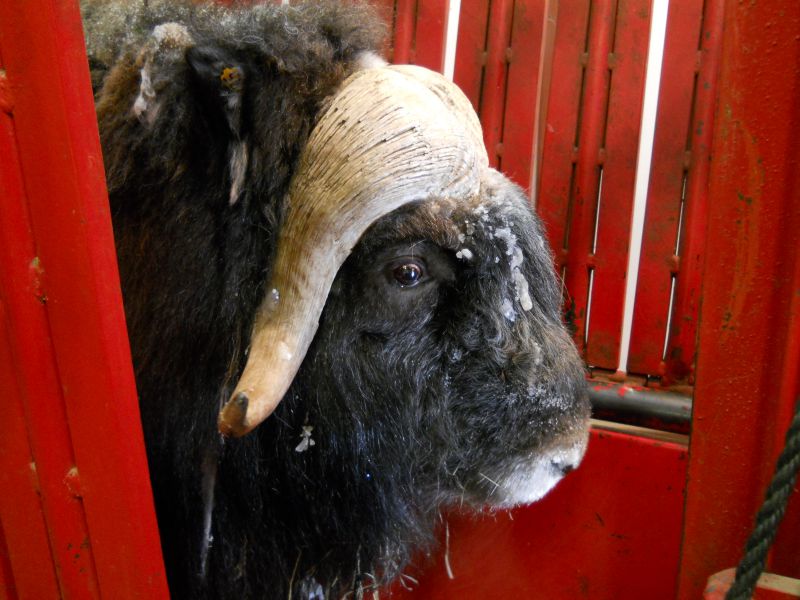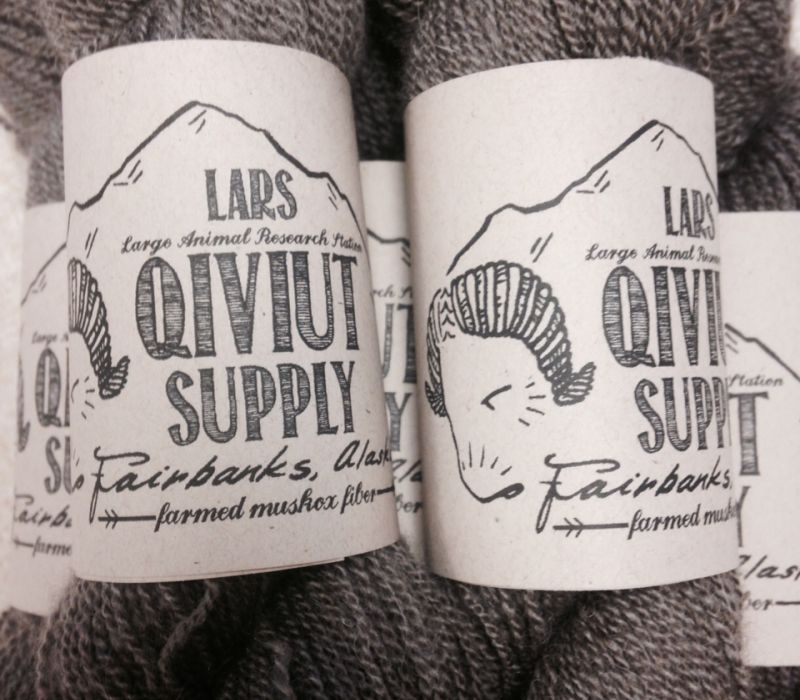This Season’s Hottest Fiber: Qiviut, the Undercoat of Musk Oxen
It’s called “qiviut,” and it might produce the warmest sweater you’ve ever worn.
This Season’s Hottest Fiber: Qiviut, the Undercoat of Musk Oxen
It’s called “qiviut,” and it might produce the warmest sweater you’ve ever worn.

There are only two farms actively producing qiviut (kiv-ee-utt) in Alaska and none in the rest of the country, but its fantastically soft and warm qualities – plus the economic benefit it can provide Alaska – make it one of the most interesting and promising new fibers out there.
The musk ox is a gigantic bison-looking animal, though it’s actually more closely related to goats than it is to bison or cows. It’s a native Arctic animal, living in the coldest regions of North America and Greenland, but thanks to hunting for its pelt, was wiped out of Alaska in the late 1800s. Starting in 1935, though, the US government began reintroducing musk oxen back into Alaska, where now there resides a population of a few thousand.

Qiviut is not a musk ox’s wool, exactly; instead, it’s the soft, fluffy undercoat, which serves as a protective element during the long arctic winters. Each spring, it’s shed all at once. “We notice when their coats start shedding, we bring them into the barn, and we have a squeeze shoot for them so they stay nice and still,” says Freeman, who works at the university’s Large Animal Research Station, studying Arctic mammals like the musk ox and reindeer. “Then we take an afro pick to pull out the qiviut from the long guard hairs.” It’s pretty nuts: That combing process basically results in pulling what looks like an entire sweater out from within the hairs of a musk ox. Take a look:
Qiviut can be brushed from the musk ox’s coat once per year, or it can be gathered wild; the qiviut comes out in little puffs naturally, but extended exposure to the sun can make it brittle and less than ideal for fabrics. Still, an Alaskan cooperative called Oomingmak has been gathering this qiviut and spinning it into yarn to be knitted into hats, scarves, and sweaters since 1969. If you want a qiviut item, they’re one of your few options, though you can buy the yarn in a handful of shops around the world.
Freeman has been studying qiviut yarn for years to find the best way to turn the product into a viable option for Alaskan farming, and the UAF’s Large Animal Research Station is one of the two farms in the state producing the fiber. “This could potentially be a really good revenue source for Alaska,” she says. “If you think about our agriculture, it’s kind of a sorry state; we’re about 15 years behind the rest of the country.” With a 90-day growing season for produce, livestock and fiber farming might be the best option to expand Alaskan agriculture.
It won’t necessarily be easy, though. Farming qiviut is a very recent development; this isn’t an ancient fiber we’re rediscovering. It was first gathered and spun in the 1930s by a home economics teacher in Alaska, and the animal was only domesticated for its fiber in 1954, right there in the Last Frontier. Everything is new: There aren’t yet any local mills that can properly separate and process the qiviut (so, at the moment, farms have to ship their yarn out to a mill in Connecticut for processing), nobody really knows yet how to optimize the musk oxen for maximum qiviut production, and there are only about 4,000 animals in the entire state.

That said, there are many, many reasons why qiviut should be a huge success. Qiviut is, by all accounts, spectacularly soft and warm; it’s what keeps the musk ox alive through -80-degree F winters, it doesn’t pill or felt, and, as Freeman says, “there’s no scratch factor.” Upkeep is minimal: Musk oxen are built for the Arctic habitat to begin with, and they don’t need much since they’re able to graze for food and eat snow for water.
The prices for qiviut are insanely high right now due to the very small amount of it being produced. Raw, unprocessed qiviut goes for about $35 per ounce, which is more than twice the price of cashmere. At Oomingmak, the collective, scarves cost $275 and hats cost $190. At Cottage Craft Angora in Quebec, you can get a slightly larger collection – but sweaters are still expensive, with each near $1,000. But that’s wholly a matter of scale, says Freeman; if the interest and the processing ability is there, they can supply calves and get qiviut farming going.
After all, who knows warmth better than an Alaskan? “In Alaska you can never have too many sweaters,” says Freeman.
Follow us
This work is licensed under a Creative Commons Attribution-NoDerivatives 4.0 International License.
Want to republish a Modern Farmer story?
We are happy for Modern Farmer stories to be shared, and encourage you to republish our articles for your audience. When doing so, we ask that you follow these guidelines:
Please credit us and our writers
For the author byline, please use “Author Name, Modern Farmer.” At the top of our stories, if on the web, please include this text and link: “This story was originally published by Modern Farmer.”
Please make sure to include a link back to either our home page or the article URL.
At the bottom of the story, please include the following text:
“Modern Farmer is a nonprofit initiative dedicated to raising awareness and catalyzing action at the intersection of food, agriculture, and society. Read more at <link>Modern Farmer</link>.”
Use our widget
We’d like to be able to track our stories, so we ask that if you republish our content, you do so using our widget (located on the left hand side of the article). The HTML code has a built-in tracker that tells us the data and domain where the story was published, as well as view counts.
Check the image requirements
It’s your responsibility to confirm you're licensed to republish images in our articles. Some images, such as those from commercial providers, don't allow their images to be republished without permission or payment. Copyright terms are generally listed in the image caption and attribution. You are welcome to omit our images or substitute with your own. Charts and interactive graphics follow the same rules.
Don’t change too much. Or, ask us first.
Articles must be republished in their entirety. It’s okay to change references to time (“today” to “yesterday”) or location (“Iowa City, IA” to “here”). But please keep everything else the same.
If you feel strongly that a more material edit needs to be made, get in touch with us at [email protected]. We’re happy to discuss it with the original author, but we must have prior approval for changes before publication.
Special cases
Extracts. You may run the first few lines or paragraphs of the article and then say: “Read the full article at Modern Farmer” with a link back to the original article.
Quotes. You may quote authors provided you include a link back to the article URL.
Translations. These require writer approval. To inquire about translation of a Modern Farmer article, contact us at [email protected]
Signed consent / copyright release forms. These are not required, provided you are following these guidelines.
Print. Articles can be republished in print under these same rules, with the exception that you do not need to include the links.
Tag us
When sharing the story on social media, please tag us using the following: - Twitter (@ModFarm) - Facebook (@ModernFarmerMedia) - Instagram (@modfarm)
Use our content respectfully
Modern Farmer is a nonprofit and as such we share our content for free and in good faith in order to reach new audiences. Respectfully,
No selling ads against our stories. It’s okay to put our stories on pages with ads.
Don’t republish our material wholesale, or automatically; you need to select stories to be republished individually.
You have no rights to sell, license, syndicate, or otherwise represent yourself as the authorized owner of our material to any third parties. This means that you cannot actively publish or submit our work for syndication to third party platforms or apps like Apple News or Google News. We understand that publishers cannot fully control when certain third parties automatically summarize or crawl content from publishers’ own sites.
Keep in touch
We want to hear from you if you love Modern Farmer content, have a collaboration idea, or anything else to share. As a nonprofit outlet, we work in service of our community and are always open to comments, feedback, and ideas. Contact us at [email protected].by Dan Nosowitz, Modern Farmer
May 31, 2016
Modern Farmer Weekly
Solutions Hub
Innovations, ideas and inspiration. Actionable solutions for a resilient food system.
ExploreExplore other topics
Share With Us
We want to hear from Modern Farmer readers who have thoughtful commentary, actionable solutions, or helpful ideas to share.
SubmitNecessary cookies are absolutely essential for the website to function properly. This category only includes cookies that ensures basic functionalities and security features of the website. These cookies do not store any personal information.
Any cookies that may not be particularly necessary for the website to function and are used specifically to collect user personal data via analytics, ads, other embedded contents are termed as non-necessary cookies.
Thank you so much. Your article was very informative. I learned so much about Musk Ox & Qivuit.
Is there something wrong with my Qiviut? I have just started knitting with it. It felts more than any other yarn I have ever worked with. I have read that it does not felt.
Thanks, Susan
I live in Nova Scotia, Canada and I love creating landscapes with wool rovings or unspun fibres. I am looking for some natural, undyed, musk ox under-hair (or fur) for my work. Please, where might I purchase some of this and would appreciate prices too. Thank you.